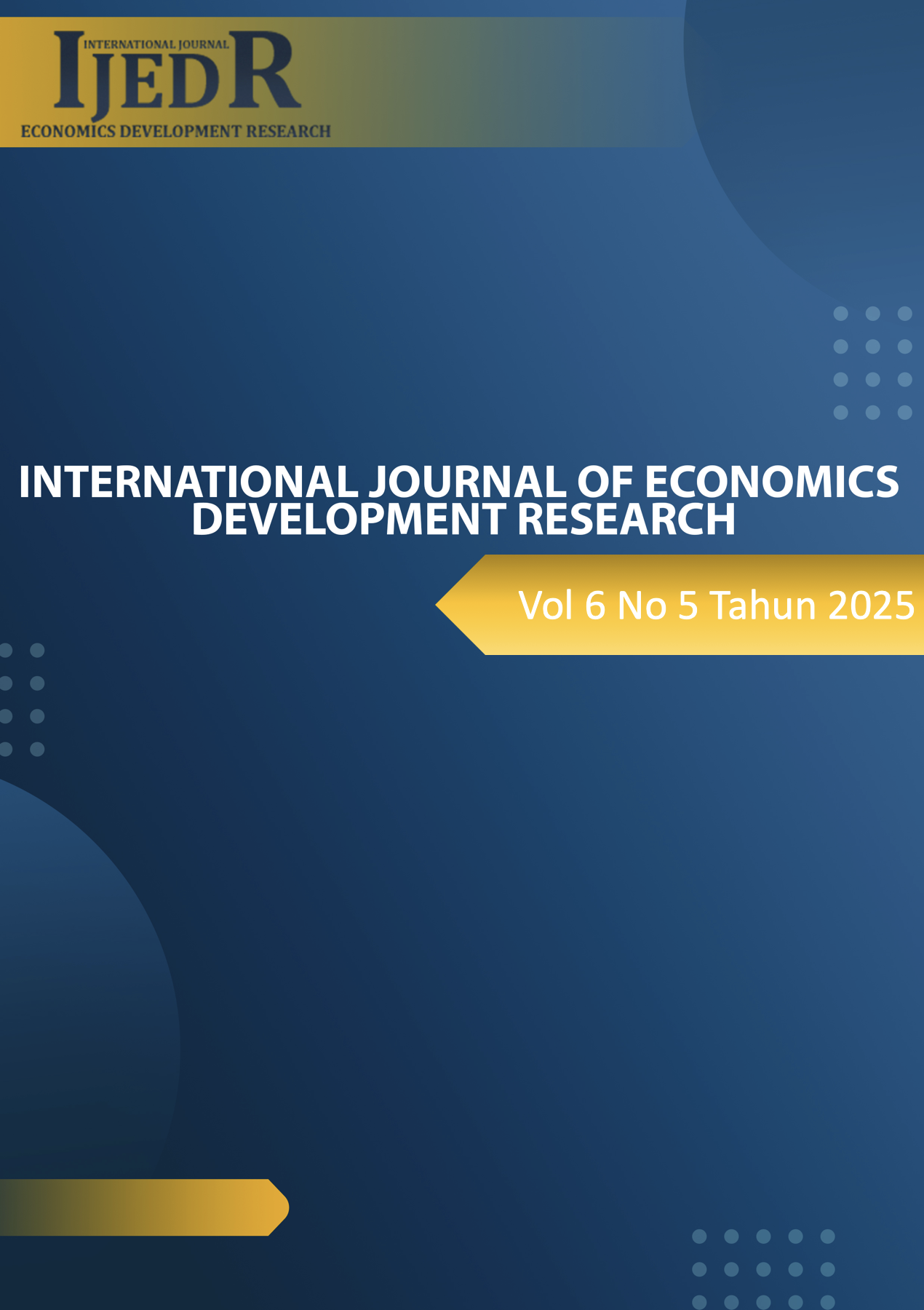Economic Perspectives of MSMEs on Peer-to-Peer Lending as Business Capital Financing in Asahan Regency
DOI:
https://doi.org/10.37385/ijedr.v6i5.8966Keywords:
MSMEs, P2P lending, Capital Financing, Economic PerceptionAbstract
This study aims to determine the perceptions of MSMEs in Asahan Regency towards peer-to-peer lending-based capital financing services. This service is presented as a digital financing alternative that offers ease and speed in accessing capital, especially for MSMEs that have difficulty obtaining capital from conventional financing. This study used a qualitative approach with interviews with 10 MSMEs, consisting of five users and five non-users of P2P lending services. Data analysis was conducted using Nvivo 12 Pro software to identify perceptions based on five components: ease, benefits, risks, challenges, and trust. The results show that MSMEs who have used P2P lending services have a positive perception of the ease and benefits directly experienced from using P2P lending services. However, they also face risks and challenges in using P2P lending services. In contrast, MSMEs who have never used P2P lending services tend to have perceptions dominated by doubt, worry, and ignorance due to lack of experience. User trust is formed through direct experience, while non-user trust relies more on reputation and information from their surroundings.
References
Abbasi, K., Alam, A., Ahmed, N., & Ali, I. (2021). P2P lending fintechs and SMEs' access to finance. Economics Letters, 204, 109890. https://doi.org/10.1016/j.econlet.2021.109890
Aprialdi, F., & Dalimunthe, M. (2023). Analysis of student literacy at State Islamic University North Sumatra against online loans. Tapis: Journal of Scientific Research, 7(2), 173–181.
Del Sarto, N. (2025). Exploring peer-to-peer lending: key influences of firm uncertainty, loan features and venture quality. International Journal of Bank Marketing, 43(3), 591–614. https://doi.org/10.1108/IJBM-04-2024-0239
Galema, R. (2020). Credit rationing in P2P lending to SMEs: Do lender–borrower relationships matter? Journal of Corporate Finance, 65, 101742. https://doi.org/10.1016/j.jcorpfin.2020.101742
Ghazali, N. H., & Yasuoka, T. (2018). Awareness and perception analysis of small medium enterprise and start-up towards FinTech instruments: Crowdfunding and peer-to-peer lending in Malaysia. International Journal of Finance and Banking Research, 4(1), 13–24. https://doi.org/10.11648/j.ijfbr.20180401.12
Kholidah, H., Mawardi, I., & Huda, N. (2022). A bibliometric mapping of peer-to-peer lending research based on economic and business perspective. Heliyon, 8(April), e11512. https://doi.org/10.1016/j.heliyon.2022.e11512
Kumar, D., Phani, B. V., Chilamkurti, N., Saurabh, S., & Ratten, V. (2023). Filling the SME credit gap: A systematic review of blockchain-based SME finance literature. Journal of Trade Science, 11(2/3), 45–72. https://doi.org/10.1108/JTS-06-2023-0003
Latifah, F., Ardiani, N., Ariyanti, N., & Syafitri, M. (2023). Fintech peer-to-peer lending sharia as an alternative capital for MSME in Sidoarjo. Jurnal Ekonomi dan Keuangan Islam, 18(3), 1–11.
Liu, Y., Fujiwara, K., & Jinushi, T. (2024). Peer-to-peer lending for individual and MSME finance: Evidence from an original survey in China. International Review of Economics & Finance, 93, 38–51. https://doi.org/10.1016/j.iref.2024.02.038
Niazi, T. H., Cole, R. A., Lee, J., Su Kim, S., & Han, J. J. (2021). Public lending schemes for SMEs in Asia and the Pacific: Lessons from the Republic of Korea and the United States. Asian Development Bank Briefs. https://doi.org/10.22617/BRF210461-2
Nurbaiti, N., Asmuni, A., Soemitra, A., Imsar, I., & Aisyah, S. (2023). Behavior analysis of MSMEs in Indonesia using fintech lending: Comparative study between sharia fintech lending and conventional fintech lending. Jurnal Ekonomi Syariah, 9(4), 92–99.
Palmieri, E., & Ferilli, G. B. (2024). Innovating the bank–firm relationship: A spherical fuzzy approach to SME funding. European Journal of Innovation Management, 27(9), 487–515. https://doi.org/10.1108/EJIM-02-2024-0102
Pizzi, S., Corbo, L., & Caputo, A. (2020). Fintech and SMEs sustainable business models: Reflections and considerations for a circular economy. Journal of Cleaner Production, 245, 125217. https://doi.org/10.1016/j.jclepro.2020.125217
Saiedi, E., Mohammadi, A., Broström, A., & Shafi, K. (2022). Distrust in banks and fintech participation: The case of peer-to-peer lending. Entrepreneurship Theory and Practice, 46(5), 1170–1197. https://doi.org/10.1177/1042258720958020
Stanley, N., Kohardinata, C., Widianingsih, L. P., Junianto, Y., Ismawati, A. F., & Sari, E. T. (2024). Is P2P lending emerging as a new threat to bank credits? Journal of Accounting, Entrepreneurship and Financial Technology (JAEF), 6(1), 1–16. https://doi.org/10.37715/jaef.v6i1.4630
Supeni, N., Sari, M. I., & Mufida, A. (2022). Firm value: Funding decisions in banking companies. Jurnal Ilmu dan Bisnis Ekonomi, 16(2). https://doi.org/10.32812/jibeka.v16i2.187
Taleizadeh, A. A., Safaei, A. Z., Bhattacharya, A., & Amjadian, A. (2022). Online peer-to-peer lending platform and supply chain finance decisions and strategies. Annals of Operations Research, 315, 397–427. https://doi.org/10.1007/s10479-022-04648-w
Westland, J. C., Phan, T. Q., & Tan, T. (2018). Private information, credit risk and graph structure in P2P lending networks. Electronic Commerce Research. https://doi.org/10.1007/s10660-021-09489-6
Zakiyah, T., Trifiyanto, K., & Windasari, W. (2021). Fintech-based peer-to-peer (P2P) lending: A perspective of MSMEs in the new normal of the COVID-19 pandemic. Jurnal Ekonomi dan Bisnis Digital, 5(1), 26–46.





